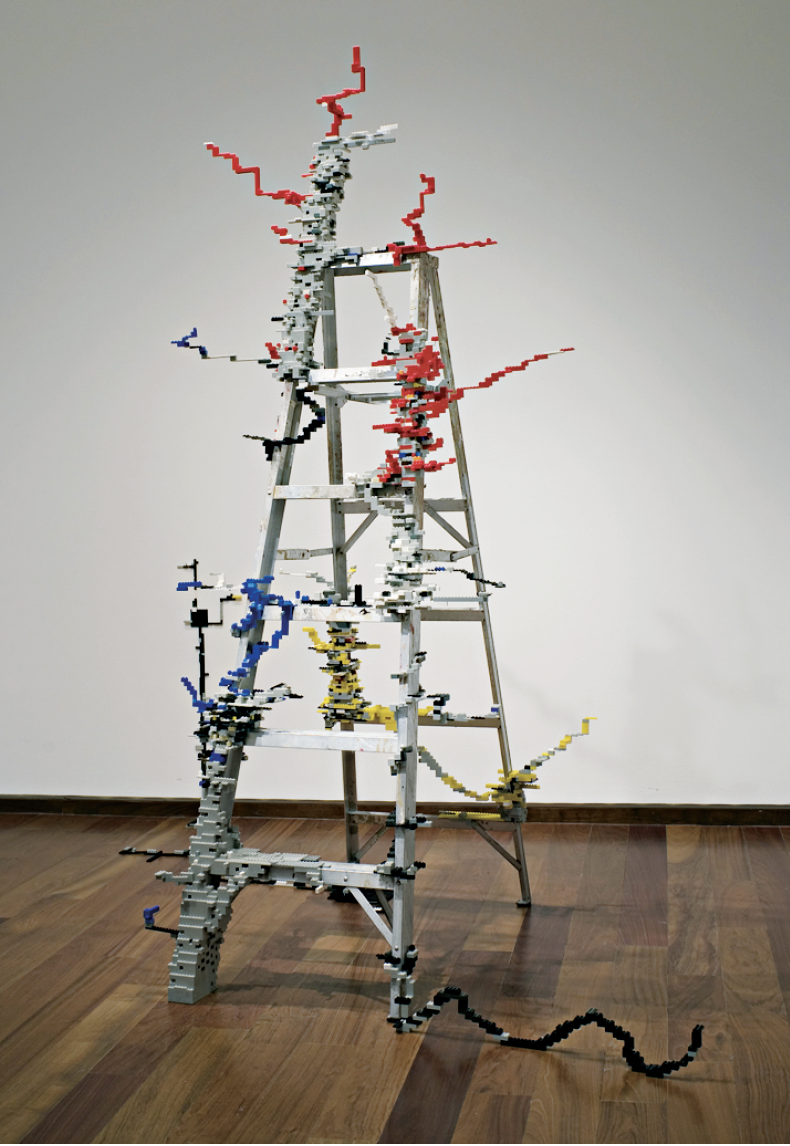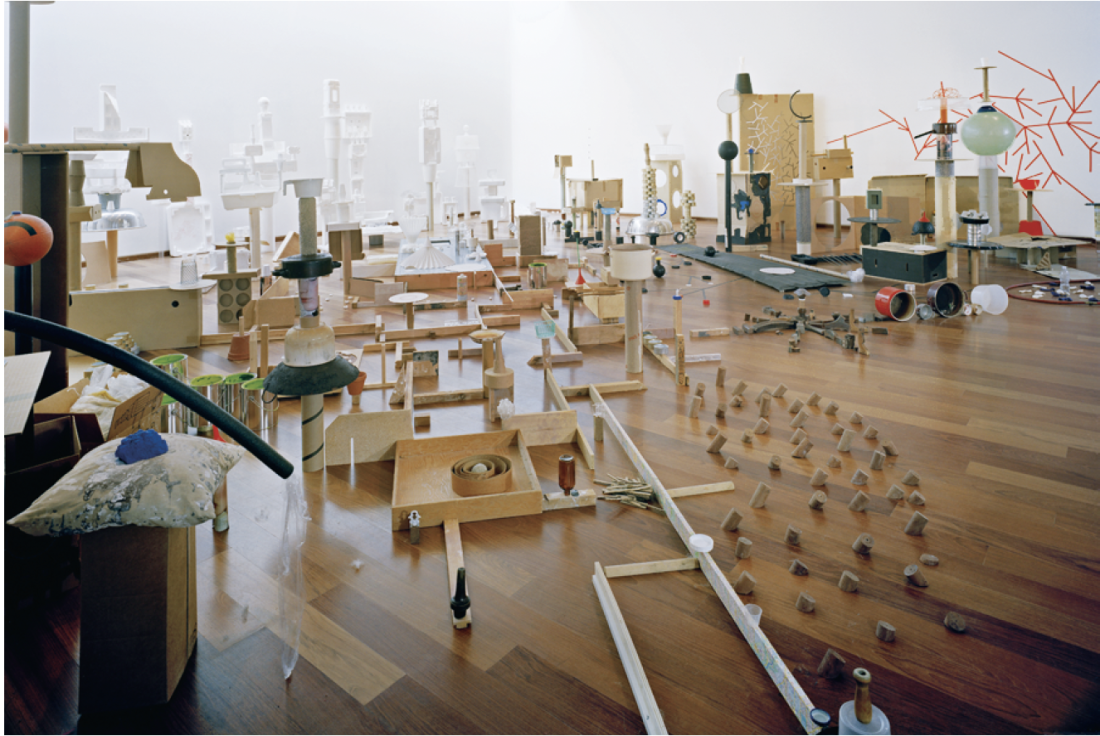Blue Republic
I’m preparing to board a plane for Tokyo and am ruefully ready to admit that the exploded, axonometric, 3-D, colour-keyed, three-tiered diagram of Narita airport, helpfully furnished by the Japan Foundation, looks a lot at the moment like a work by Blue Republic. I suppose a mock-urban, city-like place is a mock (sub)urban, city-like place, regardless of its utopian, dystopian or omnitopian ambitions and transgressions.

Blue Republic, Beautiful Infections from Alterations, 2006, six-foot-high aluminium stepladder, ready-made plastic blocks, 90” high.
Blue Republic—artists Anna Passakas and Radoslaw Kudlinski— is a Toronto-based duo with roots in their native Poland. During the past few years, the couple has been busy with ambitious installation works that tend to take the form of ruminative raids into the matrix of the urban unconscious, from which they then bear away truckloads of riff-raff trophies (chunks of Styrofoam, plastic cups, limp balloons, cooking utensils, tubes and sheets of corrugated cardboard, lengths of tubing, fashion magazines, bits of stale bread, an abandoned bottle of mineral water, etc.). These indelicate delicacies, once shaken out of their bags like kids’ candies late on Halloween night, they then cunningly arrange in galleries, resulting in tableaux that offer new and searching approaches to the inhabitable text that is the city.
Blue Republic’s vast, multi-gallery installation, “Nostalgia for the Present,” hitherto positioned on a trajectory of continuing morphological rearrangement that began at Toronto’s Peak Gallery, continued at the Koffler Gallery and the Art Gallery of Sudbury, finally came restlessly to rest this past summer at the MacLaren Art Centre in Barrie, Ontario.
However metropolitan in feeling, especially when viewed at some distance, the various phases of “Nostalgia for the Present” (“Alterations,” “Simulations,” Beautiful Infections) do not represent a convulsive fit of outlaw model making or outcroppings of city planning gone mysteriously awry. The works are more like contributions towards the construction of a para-urban sprawl of miniaturized incarnations of desire-in-abjection, a spreading out of a morphological counterpane of wondrously distaff design. Their work insinuatingly, insistently, calls into question received ideas about runaway urbanism, utopian longing, dystopian delirium, that human-all-too-human swoon towards dissolution, the awkwardness and inconvenience of aspiration, and the anxieties that lurk in longing.
Passakas and Kudlinski are not city planners. Nor, on the other hand, are they waggish hit-and-run urban delinquents. Their city-like installations are only city-surrogates, city-semblances, after all: aggregates of heterodox stuff the city continually gives off and throws up. Because this industrial detritus, after it is processed by Passakas and Kudlinski, is usually laid out in grids on the gallery floor, arranged into avenue-like and piazza-like configurations, with chunks of Styrofoam carefully stacked into towers, it looks inescapably urban/ urbane. (A previous incarnation of the work featured a toy-like “green belt”—a gathering of open cans of green paint—and a “downtown area,” bristling with hardwarestore- generated hi-rises.)

Blue Republic, Speeding from Beautiful Infections (detail), 2004, work in progress. Cardboard, fashion magazines, tin cans, Styrofoam, wood, metal, drawings on paper, wood and on wall, tempered found and ready-made objects. Approx. 96 x 300 x 540” installed.
It is interesting to note, in passing, that although the sprawling installation, “Martin Kippenberger: The Problem Perspective,” mounted at Los Angeles’s MOCA this fall and winter, shares Blue Republic’s dalliance with the arrangement of quotidian objects and materials, it is essentially a gigantic proliferation of table and desk-top assemblages, apparently addressed to a post- Kafka-esque office-vision of the bureaucratized world.
With an enormous, protean installation like Speeding, the obvious centre-piece of their “Nostalgia for the Present,” Blue Republic surrounds and engulfs the urban idea with a challenging recourse to minutiae, to morphological verbosity, creating a continually provisional and possibly toxic mini-megalopolis upon which, since you stand gazing down upon most of it, shutters itself into the status of the civic idea rendered as both sites of inspectability and the mnemonic. (“There are no miniatures in nature,” noted Susan Stewart in her 1993 study On Longing: Narratives of the Miniature, the Gigantic, the Souvenir, the Collection I am reminded.) Speeding is, among other things, funny in a mordant sort of way. But it is also a model of William Blake’s Ulro (see his study of the afflictions of our civilization, The Land of Ulro, by BR’s beloved Czeslaw Milosz, 1984), a fallen, negated Holy City which, in contrast to Blake’s radiant Beulah (“a place where Contrarities are equally True”), is a “vast Polypus of living fibres down into the Sea of Time & Space growing, a self-devouring monstrous Human Death….” (Milton, Book II). Sounds like our cities to me.

Blue Republic, Speeding from Beautiful Infections (detail), 2004, work in progress. Cardboard, fashion magazines, tin cans, Styrofoam, wood, metal, drawings on paper, wood and on wall, tempered found and ready-made objects. Approx. 96 x 300 x 540” installed.
What have we invented? “What were the phenomena of the world today?” asks a character in Norman Mailer (I think the question lurks in Barbary Shore). “There would be no solutions from the past,” I remember Mailer writing, “nor duplicates found in the present….”
As a kind of addendum, I want to look very briefly at one of the components of BR’s Beautiful Infections from the “Alterations” segment of “Nostalgia for the Present”—their now famous stepladder which, from installation to installation, becomes progressively more encrusted with Lego blocks—as if the ladder were underwater and the blocks were mussels. For me, this “infected” ladder stands at the epicenter of what Blue Republic does. Ladders are ascension machines. They are vectors of desire (think of Blake’s exquisite little etching from The Gates of Paradise, 1793, showing a ladder stretching from the earth to the moon, with a man about to make the climb; the caption reads “I want! I want!”). They help us rise above ourselves. But not BR’s ladder, where the way is blocked—albeit playfully, engagingly, even entertainingly. The Lego calligraphy infection is “beautiful,” but it end-stops our way, thwarts our desires, and keeps us tethered to the banalized, Ulro-esque country of the everyday. Where we cannot afford any longer to live. ■
“Blue Republic: Nostalgia for the Present” was exhibited at the MacLaren Art Centre in Barrie, Ontario, from June 12 to August 31, 2008.
Gary Michael Dault is a critic, poet and painter who lives in Toronto.

